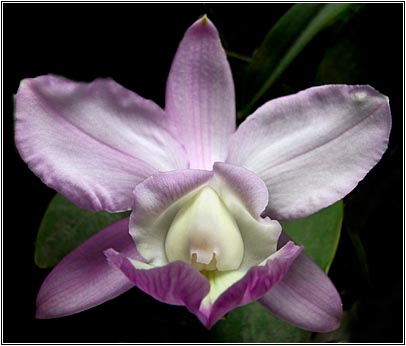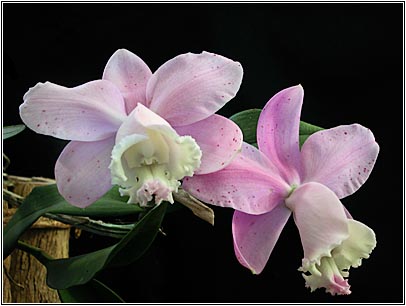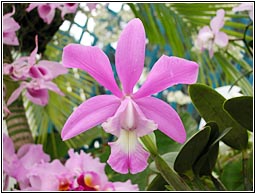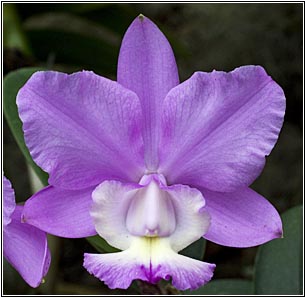
Cattleya walkeriana
(Photo: Sergio Araujo) |
Cattleya
walkeriana Gardn. (1843)
It occurs in many Brazilian states, Federal District, Goiás,
Mato Grosso do Sul, Mato Grosso, São Paulo, Paraná
but the center of dispersion is Minas Gerais.
Its habitat is quite diversified but, in general, it is dry
during the winter. This plant can occur as epiphyte or directly
on the rock. It is epiphyte in dry woodland, in the gallery
forests of the small tributaries of São Francisco river
(rivers and brooks) and on the tablelands on the big trees,
in altitude more than 1000m. On the outcrops, in the central
plateau (Minas Gerais, Goiás and São Paulo),
it vegetates as epiphyte or on the rock and expose to full
sun surrounded by the typical vegetation of cerrado (savannah).
The thought conditions found in some habitats (exposition
to full sun, high temperatures during the day and long dry
period)) are compensated by the clouds, mist and also by the
drop of temperature during the night.
Its flowers are intensively scented (like roses) and are long
lasting (from 3 to 4 weeks) and have between 6/8cm and 12/13cm
diameter. They can be isolated or from 2 to 4 flowers in the
same spike.
The buds arise from a floral atrophied leafless pseudobulb,
contrary to the other species of
|
Cattleya which
have their flowers arising from the normal pseudobulbs, in general
vigorous and with leaves. The plants of Cattleya walkeriana
type, as well as the variety princeps, eventually alternate
this kind of blooming with the ordinary kind, it means, from a normal
pseudobulb with leaves. The color varies from pink to purple or dark
purple as well beautiful 'alba' and 'semi-alba'. Natural
hybrids
x joaquiniana Miranda - Minas Gerais (C. bicolor Lindl.).
Described in 1999.
x measuresii Rchb. f. - (C. acklandiae Lindl.). Although
this hybrid has been described, there is no register of occurrence
of the two species in the same habitat.
x mesquitae L. C. Menezes – Goiás - Mato Grosso
(C. walkeriana ‘princeps’ L.C. Menezes
x C. nobilior Rchb. f.) Described in 1998 to the state of Goiás.
The reference to the state of Mato Grosso was published in an article
by Daniel Toledo, Brasil Orquídeas – ano 02 (6)108:111
Synonyms
Cattleya bulbosa Lindl. = Cattleya walkeriana
Gardn.
Cattleya gardneriana Rchb. f.= Cattleya walkeriana Gardn.
Cattleya schroederiana Rchb. f = Cattleya walkeriana Gardn.
Cattleya princeps Barb. Rodr. = Cattleya walkeriana
var. princeps L.C. Menezes
Epidendrum walkerianum Rchb. f. = Cattleya walkeriana
Gardn.
Cultivation
Although well succeeded growers use pots for the cultivation, its
disorganized and spread growth makes easier to be cultivated in
hard wood slabs, wrinkled bark or alive trees. When cultivate in
pots, be careful with the drainage and keep them hanged in order
to allow a good ventilation. It needs strong luminosity and resents
the excess of humidity during the cooler months. It should be well
watered during the growth period. It can be cultivated in warm,
temperate or even cool places, however mild temperatures are more
adequate and when cultivated in hot place all year round, the blooming
is not so exuberant. Very susceptible to aphids.
Hybridization
Often used in hybridization because it is an easy-to-grow plant
besides the good substance and the good structure of the flowers.
Its scent and its vegetative bearing are transmitted to the progeny.
The inconvenient is the number of flowers, in general, a few flowers
in each spike.
Cattleya
loddigesii Lindley. (1823)
It was
the first Cattleya to be introduced in Europe.
Bifoliate Cattleya, it occurs in the state of Bahia,
Espírito Santo, Minas Gerais, Paraná, Rio
de Janeiro and São Paulo but it is spread until Paraguay.
The mainly habitats are situated in Minas Gerais and São
Paulo on the slopes of the mountains covered by the Atlantic
Forest, in regions covered by mist, situated between 500
and 900m altitude.
In the south of the state of Minas Gerais, it is frequent
associated to C. walkeriana where the hybrid C.
x dolosa is not rare.
It vegetates between 600 and 900m altitude. The flowers
vary between 8 and 11cm but it can reach 12 cm diameter.
The floral spike bear from 2 to nine flowers.
They emerge from a dried sheath contrary to Cattleya
harrisoniana (with what is frequently confused) which
flowers open from a green sheath.
|
 Cattleya
loddigesii (Photo: Sergio Araujo)
Cattleya
loddigesii (Photo: Sergio Araujo) |
The period of bloom starts later Fall until the early Springtime.
The color varies from soft pink until dark pink and the petals have
soft undulated margins. This is a plant that has undergone by many
crosses in order to get genetic improvements and for obtaining new
varieties. So, nowadays, it is found in a quite good range of variety
since the soft pink until the spotted pink besides the 'alba'.
Cultivation
It is more adequate to be cultivate under mild or cool temperatures
or in a place where the temperature drops every night. It needs
high humidity during the growth period and a reduction (not interruption)
during the cooler months. It should be protected from the strong
luminosity.
Hybrids:
Beside Cattleya x dolosa, another natural hybrids have
been found:
Cattleya
x hybrida Veitch (1863)- RJ (C. guttata Lindl.)
x o’brieniana Rolfe - MG ( C. dolosa Rchb. f.)
x sororia Rchb. f. - sine loco, (C. bicolor Lindl.)
(Synonym: C. X sanchesiana)
x valentine - ES (C. warneri Moore)
Laeliocattleya
x amoena Blue - RJ (Laelia perrinii Lindl.)
x fredna (?) - SP (Laelia lundii Rchb. f. )
x lambari Pabst - MG [Laelia crispata (Thunb.)
Miranda]
x leeana Rchb. f. - ES [L. pumila (Hook.) Rchb.
f.]
Synonyms of Cattleya loddigesii
Lindl.
Cattleya arembergii Scheidw.
Cattleya candida Williams
Epidendrum loddigesii Rchb. f.
Epidendrum canaliculatum Velllozo
Epidendrum violaceum Loddiges
Cattleya ovata Lindley (l838)
C. X sanchesiana = x sororia Rchb. f.
|
Cattleya
x dolosa Rchb.
f. (1874)
It occurs in Minas Gerais and São Paulo
Second generation hybrid
x o’brieniana Rolfe
- MG ( C. loddigesii)
x schroederaana Rchb. f. (or schroederiana Rchb.
f.) - MG (C. bicolor Lindl.)
Synonyms
of Cattleya x dolosa Rchb. f.
Cattleya eximia Barb. Rodr. = Cattleya
x dolosa Rchb. f.
Cattleya walkeriana var. dolosa Veitch.
= Cattleya x dolosa Rchb. f.
Epidendrum dolosum Rchb.f.
= Cattleya x dolosa Rchb.
f. 
x
o’brieniana (Photo:
Sergio Araujo) |

Cattleya
x dolosa Rchb. f. (Photo:
Sergio Araujo)
|
The
occurrence of the other species referred for this habitat, registered
in the Brazilian specialized literature:
Bletia catenulata Ruiz & Pavón DF, Goiás
(GO), Maranhão (MA), Minas Gerais (MG), Mato Grosso do Sul
(MS), Mato Grosso (MT), Pará (PA), Rio de Janeiro (RJ), São
Paulo (SP), Tocantins (TO)
Brassavola tuberculata Hook - Alagoas (AL), Ceará
(CE), Espírito Santo (ES), MG, MS, Pernambuco (PE), Paraíba
(PB), Paraná (PR), RJ , Rio Grande do Sul (RS), Santa Catarina
(SC), Sergipe (SE)
Bulbophyllum plumosum (Barb. Rodr.) Cogn. - GO, MG, PR,
RJ
Bulbophyllum warmingianum Rchb .f. - Bahia (BA), ES, GO,
MG, RJ, SC, SP
Cyrtopodium cardiochilum Lindl. - ES, MG, RJ (species not
well defined)
Cyrtopodium triste Rchb. f. & Warm.– DF, GO,
MG, MS, MT,PA, SP, TO
Epidendrum avicula (Lindl.) Benth. - AL, DF, ES, GO, MG,
MT, PE, PR, RJ, RS, SC, SP
Epidendrum secundum Jacq. - Amazonas (AM), Amapá
(AP), BA, CE, DF, GO, MG, MT, PA, PE, PR, RJ, Roraima (RR), RS,
SC, SP
Epidendrum dendrobioides Thunb. - DF, GO, MG, MT, RJ, RR,
SP
Isochilus linearis (Jacq.) R. Br. - AL, CE, DF, ES, MG,
MT, PA, PE, PR, RJ, RN, RR, RS, SC, SP
Oeceoclades maculata (Lindley) Lindley - AL, AM, AP, BA,
CE, DF, ES, GO, MA, MG, MS, MT, PA, PE, PB, PR, RJ, RN, RR, RS,
SC, SP
Oncidium euxanthinum Rchb. f. or Oncidium varicosum
Lindl. var. rogersii - MG, SP
Phragmipedium vittatum (Vell.) Rolfe - DF, GO, MG, MS ,
RJ, SP, TO
Pleurothallis johannensis Barb. Rodr. - BA, ES, MG, RJ
Sophronitis cernua Lindl. - AL, BA, ES, GO, MG, PE, PR,
RJ, RS, SC, SP
Some synonyms:
Epidendrum
alsum Ridl.ex Thurn. = Epidendrum dendrobioides Thunb.
Epidendrum carnosum Lindl. = Epidendrum dendrobioides
Thunb.
Epidendrum crassifolium Lindl. = Epidendrum secundum
Jacq.
Epidendrum durum Lindl. = Epidendrum dendrobioides
Thunb.
Epidendrum ellipticum Graham = Epidendrum secundum
Jacq.
Epidendrum elongatum Jacq = Epidendrum secundum
Jacq.
Epidendrum herzogii Schltr. = Epidendrum secundum
Jacq.
Epidendrum longihastatum = Epidendrum secundum Jacq.
Epidendrum versicolor = Epidendrum secundum Jacq.
Lanium avicula Lindl. = Epidendrum avicula (Lindl.)
Benth.
Bibliography
Pescatorea - Jean Linden, Iconografia das Orquídeas,
reedição Naturalia Publications - 1996.
Flora Brasiliensis, Volumen III Pars V. Von Martius.
The Manual of Cultivate Orchid Species - Helmut Bechtel - Phillip
Cribb - Edumnd Launert - 3rd edition.1992
The Brazilian Bifoliate Cattleyas and Their Color Varieties , J.
A. Fowlie.
the Cattleyas and Their Relatives,Vol I. The Cattleyas - Carl L.
Withner. 1995
Orchidaceae Brasilienses - Pabst & Dungs - vol I 1975
World Checklist of Monocotyledons - http://www.kew.org - outubro
2007
Orquídeas da Chapada Diamantina Toscano de Brito e Phillip
Cribb - 2005
|



